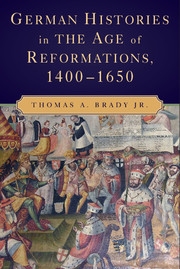Book contents
- Frontmatter
- Contents
- Figures, Maps, and Tables
- Acknowledgments
- A Note on Usages
- Map 1 The Empire in 1547
- Map 2 The Peace of Westphalia, 1648
- Part I The Empire, the German Lands, and Their Peoples
- Part II Reform of the Empire and the Church, 1400–1520
- Part III Church, Reformations, and Empire, 1520–1576
- Part IV Confessions, Empire, and War, 1576–1650
- 13 Forming the Protestant Confessions
- 14 Reforming the Catholic Church
- 15 Limits of Public Life – Jews, Heretics, Witches
- 16 Roads to War
- 17 The Thirty Years War
- 18 German Reformations, German Futures
- Appendix
- Glossary
- Bibliography
- Index
17 - The Thirty Years War
Published online by Cambridge University Press: 05 June 2012
- Frontmatter
- Contents
- Figures, Maps, and Tables
- Acknowledgments
- A Note on Usages
- Map 1 The Empire in 1547
- Map 2 The Peace of Westphalia, 1648
- Part I The Empire, the German Lands, and Their Peoples
- Part II Reform of the Empire and the Church, 1400–1520
- Part III Church, Reformations, and Empire, 1520–1576
- Part IV Confessions, Empire, and War, 1576–1650
- 13 Forming the Protestant Confessions
- 14 Reforming the Catholic Church
- 15 Limits of Public Life – Jews, Heretics, Witches
- 16 Roads to War
- 17 The Thirty Years War
- 18 German Reformations, German Futures
- Appendix
- Glossary
- Bibliography
- Index
Summary
Through the Peace of Westphalia the Protestant Church had been acknowledged as an independent one – to the great confusion and humiliation of Catholicism. This peace has often passed for the palladium of Germany, as having established its political constitution. But this constitution was in fact a confirmation of the particular rights of the countries into which Germany had been broken up. It involves no thought, no conception of the proper aim of a state.
G. W. F. HegelThe Thirty Years War ended centuries of the German lands' relative isolation and brought their age of reformations to a close. It began as a double reprise: the Bohemian revolt against Emperor Ferdinand II in 1618 reprised the Hussite revolt against Sigismund 200 years before; the ensuing war between the emperor and German Protestant princes emulated the German wars of religion between 1546 and 1552. German history contained no precedents, however, for the massive, repeated, and decisive intrusions of foreign military powers – Denmark, Sweden, and France – which transformed a German civil war into the most complex of struggles.
Historians commonly divide the Thirty Years War into four phases, each named for the principal military antagonist of the emperor and the Catholic League:
1. the Bohemian War (1618–23), from the Bohemian revolt against Emperor Ferdinand II through the Catholic League's occupation of the Rhine Palatinate and Lower Saxony;
2. the Danish War (1625–29), from the Danish intervention to the Edict of Restitution;
3. the Swedish War (1630–35), from the Swedish invasion to the Peace of Prague; and
[…]
- Type
- Chapter
- Information
- German Histories in the Age of Reformations, 1400–1650 , pp. 375 - 404Publisher: Cambridge University PressPrint publication year: 2009

